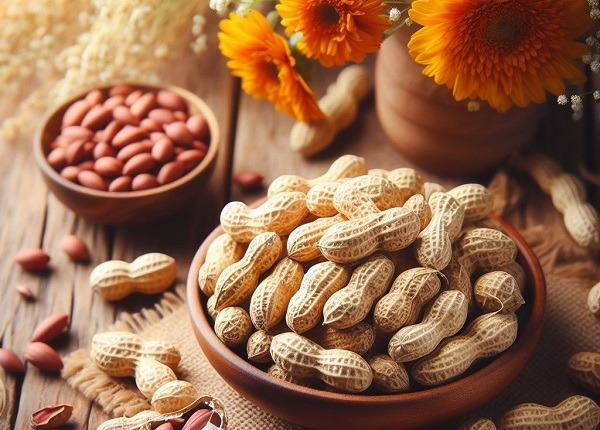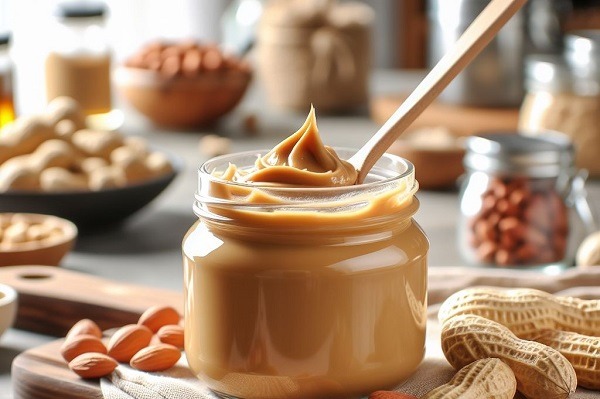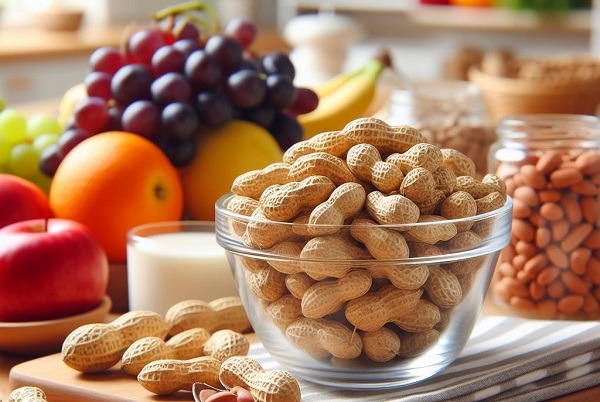Peanuts might be more diet-friendly than you think! Let’s explore whether are peanuts low FODMAP and what that means for folks trying to manage conditions like IBS.
What Are Peanuts?
Peanuts: they’re crunchy, delicious, and a staple in many diets around the world. But what exactly are they? Despite often being grouped with tree nuts like almonds and walnuts, peanuts are technically legumes (similar to beans and lentils). They grow underground, which is why they’re sometimes called groundnuts.
Nutritional Spotlight
Peanuts are packed with energy, containing high levels of protein, essential fats, and various vitamins and minerals. They’re an excellent source of biotin, Vitamin E, and several B vitamins which are crucial for brain health and energy levels.
But here’s an interesting twist—despite their rich nutrient profile, the FODMAP content in peanuts is surprisingly low compared to other legumes, making them potentially a good nut option for those on a restricted diet.
Peanuts in Different Forms
When we talk about eating peanuts, it’s not just about grabbing a handful from your snack drawer. Peanuts can be enjoyed raw, roasted, or even as peanut butter.
Each form of peanut consumption brings its own set of nutrients and benefits. For instance, raw peanuts retain most of their natural antioxidants, while roasting can enhance flavor and digestibility.
The FODMAP Diet Explained
Think all healthy foods sit well with your stomach? Not always the case, especially if you’re one of the many dealing with sensitive digestion, like those with IBS. Enter the FODMAP diet, a go-to for many seeking relief from gastrointestinal discomfort. But what’s this diet all about?
What is a Low FODMAP Diet?
FODMAPs are a group of carbohydrates that are notorious for causing digestive issues in sensitive individuals. The term stands for Fermentable Oligosaccharides, Disaccharides, Monosaccharides, And Polyols—quite the mouthful, right? These are small sugars and fibers that the gut can find tough to digest.
Why It Matters
For those with irritable bowel syndrome (IBS) or similar conditions, sticking to a low FODMAP diet can significantly reduce symptoms like bloating, gas, and stomach pain. This diet involves a process of elimination and reintroduction to identify which foods are triggers, helping individuals tailor their eating habits to what their bodies can handle.
Are Peanuts Low FODMAP?
Navigating a low FODMAP diet can feel like walking through a minefield for your gut. One wrong step (or bite) and you’re in for an uncomfortable day. So, let’s talk peanuts—are they safe to snack on?
The Low FODMAP Status of Peanuts
Good News for Nut Lovers Yes, peanuts are indeed low FODMAP! They’re a fantastic option for anyone looking to manage digestive symptoms related to IBS and similar conditions. However, like with all things FODMAP, portion control is crucial.
Recommended Serving Size A serving size of about 28 grams (that’s roughly a small handful) is considered safe and shouldn’t trigger symptoms for most people. This makes peanuts a convenient and gut-friendly snack.
Why Peanuts Are Low FODMAP Friendly
Nutritional Composition Peanuts are primarily composed of protein and fats, which do not contain FODMAPs. The FODMAPs present in foods are types of carbohydrates, and luckily, the types in peanuts are not the ones that generally trigger sensitivities.
Digestibility Compared to other legumes, peanuts have a simpler starch structure, making them easier on your digestive system. This makes them a better choice for those following a low FODMAP diet.
Incorporating Peanuts into Your Diet
Snacking Smart Peanuts are versatile! Eat them alone, toss them into a salad for some extra crunch, or stir them into a low FODMAP trail mix with suitable seeds and dried fruits (in moderation).
Cooking with Peanuts They’re not just for snacking. Ground peanuts can add a rich, nutty flavor to sauces and marinades, or give a crunchy topping to low FODMAP-friendly desserts.
Is Peanut Butter Low FODMAP?
It’s a common question popping up for anyone diving into a low FODMAP diet: Can I still enjoy peanut butter? Good news—you don’t have to cut out this beloved spread from your diet. However, not all peanut butter is created equal when it comes to FODMAPs.
Understanding Peanut Butter and FODMAPs
What Makes Peanut Butter Low FODMAP? Peanut butter can indeed be a low FODMAP option if you choose wisely. Pure peanut butter that contains only peanuts and perhaps a small amount of salt is typically low in FODMAPs. The problems arise with additives.
Choosing the Right Peanut Butter
Avoid High FODMAP Additives Many commercial peanut butter include high FODMAP ingredients like honey, agave syrup, or high fructose corn syrup. Always read the label to ensure that your peanut butter doesn’t contain these sneaky additives.
Go for Natural and Simple The best choice is natural peanut butter with no added sugars or oils. These versions keep it simple: just peanuts, which is exactly what you want on a low FODMAP diet.
How Much Peanut Butter Can You Eat?
Portion Size Matters Like with whole peanuts, the amount of peanut butter you can safely consume without triggering symptoms is about two tablespoons. This serving size keeps the FODMAP level in check and allows you to enjoy peanut butter without worries.
Delicious Peanut Butter Recipe Ideas
Peanut butter is incredibly versatile. Here are a couple of quick, low FODMAP ideas:
- Peanut Butter Banana Smoothie: Blend a tablespoon of natural peanut butter with a ripe banana (ripe bananas in small portions are low FODMAP) and a cup of lactose-free milk or almond milk for a refreshing drink.
- Peanut Butter Oatmeal: Stir a spoonful of peanut butter into your morning oatmeal made with water or a low FODMAP milk alternative.
Safe Ways to Enjoy Peanuts on a Low FODMAP Diet
Contrary to popular belief, not all tasty snacks are off-limits on a low FODMAP diet. Peanuts, for instance, can still be on the menu! Here’s how you can keep snacking on these crunchy delights without worry:
How to Include Peanuts in a Low FODMAP Diet
- Portion Control: As we mentioned earlier, keeping to a small handful of peanuts (about 28 grams) helps manage their FODMAP load, making them a good snack choice. This is key in preventing the common symptoms associated with larger servings of legumes.
- Choose Natural Forms: Opt for natural, unsalted peanuts without additional flavors or coatings. Many additives and flavorings can contain high FODMAP ingredients that could negate the benefits of sticking to plain peanuts.
Are Salted Peanuts Low FODMAP
Yes, salted peanuts are low FODMAP in moderation. The key is to stick to a small serving size—about 28 grams or a small handful. Ensure they are plain salted peanuts without any high FODMAP additives like garlic or onion powder to keep your snack FODMAP-friendly and digestion smooth.
Are Roasted Peanuts Low FODMAP
As long as they are eaten in moderation, roasted peanuts are indeed low in FODMAP foods. About 28 grams is the suggested serving size, or about a tiny handful. To keep roasted peanuts low FODMAP, make sure to select them free of high FODMAP seasonings or additives like honey, garlic, or onion powder.
Low FOPMAP Diet
Is Cranberry Juice Low FODMAP?
How Is Almond Milk Low FODMAP?
Is Cranberry Sauce Low FODMAP?
How Is Coconut Milk Low FODMAP?
Peanuts and Digestive Health
Many assume that all legumes are problematic for those with digestive issues, but let’s clear the air—peanuts are a bit different.
How Peanuts Affect Digestion
- Rich in Protein and Fat: These nutrients in peanuts don’t typically trigger FODMAP-related symptoms, which primarily stem from certain carbohydrates.
- Digestive Benefits: Peanuts are also rich in dietary fiber, which can aid in regular bowel movements and overall gut health, provided they are consumed in moderation.
- Do Peanuts Cause Gas?: While some individuals might experience gas with larger amounts of peanuts, sticking to the recommended serving size usually keeps discomfort at bay.
- Can Peanuts Cause FODMAP Related Symptoms?: If consumed within the low FODMAP serving guidelines, peanuts are generally safe and shouldn’t trigger symptoms.
Benefits of Peanuts
Peanuts might just be the unsung heroes of the snack world. Not only are they tasty and satisfying, but they also pack a hefty nutritional punch. Here’s why you might want to reach for a handful of peanuts next time you need a snack.
Packed with Essential Nutrients
Rich in Protein: Peanuts are an excellent source of plant-based protein, making them a great option for vegetarians and vegans looking to boost their protein intake. Just a small handful can help fuel your body with the essential amino acids it needs.
Full of Healthy Fats: Despite the bad rap that fats often get, the fats in peanuts are good for you. They’re rich in monounsaturated and polyunsaturated fats, which can help manage cholesterol levels and reduce the risk of heart disease.
Boosts Heart Health
Eating peanuts may contribute to a healthy heart. Studies have shown that regular peanut consumption can lower bad cholesterol (LDL) levels without affecting good cholesterol (HDL). This can lead to a lower risk of cardiovascular disease.
Aids in Weight Management
Thanks to their protein and fiber content, peanuts are a filling snack that can help keep hunger at bay between meals. This makes them a valuable ally in weight management, as they help prevent overeating.
Supports Blood Sugar Control
Peanuts have a low glycemic index, which means they have a slower impact on your blood glucose levels. This slow release of glucose into your blood helps manage blood sugar spikes, which is particularly beneficial for people with diabetes.
Rich in Vitamins and Minerals
Peanuts are a good source of several vitamins and minerals, including biotin, copper, niacin, folate, manganese, vitamin E, thiamine, phosphorus, and magnesium. These nutrients are vital for brain health, immune function, and bone strength.
Antioxidant Properties
Peanuts contain antioxidants such as resveratrol, p-coumaric acid, and isoflavones. Antioxidants help combat oxidative stress in your body, which reduces the risk of chronic diseases and helps keep you healthy.
Alternatives and Comparisons
Many folks assume that if peanuts work for them on a low FODMAP diet, all nuts must be equally safe. However, not all nuts are created equal in terms of FODMAP content. Understanding these differences can help you make smarter choices for your snacks and meals.
Comparing Peanuts to Other Nuts
- Peanuts vs. Almonds: Almonds are another popular nut choice, but they have a higher FODMAP content compared to peanuts. While you can eat about 10-15 almonds safely, any more might trigger symptoms for those with sensitivities.
- Peanuts vs. Cashews: Cashews are, unfortunately, a high FODMAP nut and are generally best avoided if you’re following a strict low FODMAP diet. They contain more of the FODMAPs that can cause digestive distress.
Safe Nut Alternatives
If you’re looking for variety or can’t eat peanuts, here are some great low FODMAP alternatives:
- Walnuts: These are a low FODMAP choice and can be eaten in similar portion sizes to peanuts. They’re also rich in omega-3 fatty acids, which are great for overall health.
- Pecans: Like walnuts, pecans are low in FODMAPs and safe in moderate amounts. They add a lovely, buttery texture to dishes.
Recipe Ideas with Alternatives
- Walnut Pesto: Swap out traditional pine nuts (which can be high in FODMAPs) for walnuts in your next batch of pesto. It’s delicious with gluten-free pasta or as a spread on low FODMAP bread.
- Pecan Oatmeal Topping: Add some crushed pecans to your oatmeal for a crunchy, nutritious start to your day.
Low FODMAP Peanut Recipes
It’s a common misconception that following a low FODMAP diet means dull, flavorless meals. Not true! With peanuts, you can spice up your diet without triggering your symptoms. Here’s how you can incorporate peanuts into your low FODMAP meals to keep things tasty and varied.
Creative Peanut Recipes for a Low FODMAP Diet
- Peanut Chicken Lettuce Wraps: Use natural peanut butter to make a savory sauce, toss with grilled chicken strips, and serve in a crisp lettuce leaf. It’s a refreshing meal that’s both filling and low FODMAP.
- Low FODMAP Peanut Butter Cookies: Combine gluten-free flour with natural peanut butter, a suitable sweetener like maple syrup (in moderation), and an egg. Bake for a delicious treat that won’t derail your diet.
Tips for Cooking with Peanuts
- Keep It Natural: Always use natural, unsalted peanuts or peanut butter without additives to avoid high FODMAP ingredients.
- Moderation Is Key: Remember to stick to recommended serving sizes to avoid potential digestive discomfort.
Final Thoughts
Wrapping up, we’ve uncovered that are peanuts low fodmap. They offer not only a tasty snack option but also the flexibility to be incorporated into various dishes safely. If you’re managing a sensitive gut, don’t shy away from experimenting with peanuts. They could add not only nutritional value but also a delightful crunch to your diet!
Frequently Asked Questions
Here are some common questions.
Can I eat peanuts if I have IBS?
Absolutely! Peanuts are low FODMAP and generally well-tolerated by individuals with IBS, provided you stick to the recommended serving size of about 28 grams (a small handful).
Are all types of peanut butter safe on a low FODMAP diet?
Not all peanut butter is created equal. Look for natural peanut butter that lists peanuts and maybe a bit of salt as its only ingredients. Avoid peanut butter with added sweeteners like honey or high fructose corn syrup.
What other nuts are low FODMAP?
Alongside peanuts, walnuts and pecans are good low FODMAP choices. Like peanuts, they should be consumed in moderation according to recommended serving sizes.









